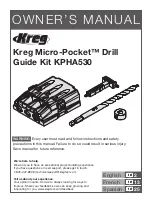
7
English
5) Service
a) Have your power tool serviced by a qualified repair
person using only identical replacement parts.
This will ensure that the safety of the power tool
is maintained.
PRECAUTION
Keep children and infirm persons away.
When not in use, tools should be stored out of reach of
children and infirm persons.
WALL CHASER SAFETY WARNINGS
a) Read all safety warnings, instructions, illustrations
and specifications provided with this power tool.
Failure to follow all instructions listed below may
result in electric shock, fire and/or serious injury.
b) Always use guard provided with the tool. The guard
must be securely attached to the power tool and
positioned for maximum safety, so the least amount
of wheel is exposed towards the operator. Position
yourself and bystanders away form the plane of the
rotating wheel.
The guard helps to protect operator from broken
wheel fragments and accidental contact with wheel.
c) Use only flat reinforced or diamond cut-off wheels
for your power tool.
Just because an accessory can be attached to your
power tool, it does not assure safe operation.
d) The rated speed of the wheel must be at least equal
to the maximum speed marked on the power tool.
Wheels running faster than their rated speed can
break and fly apart.
e) Wheels must be used only for recommended
applications. For example: do not grind with the side
of cut-off wheel.
Abrasive cut-off wheels are intended for peripheral
grinding, side forces applied to these wheels may
cause them to shatter.
f)
Always use undamaged wheel flanges that are of
correct diameter for your selected wheel.
Proper wheel flanges support the wheel thus reducing
the possibility of wheel breakage.
g) Do not use worn down flat reinforced wheels from
larger power tools.
Wheels intended for a larger power tool are not
suitable for the higher speed of a smaller tool and
may burst.
h) The outside diameter and the thickness of your
wheel must be within the capacity rating of your
power tool.
Incorrectly sized wheels cannnot be adequately
guarded or controlled.
i)
The arbour size of wheels and flanges must properly
fit the spindle of the power tool.
Wheels and flanges with arbour holes that do not
match the mounting hardware of the power tool will
run out of balance, vibrate excessively and may cause
loss of control.
j)
Do not use damaged wheels. Before each use,
inspect the wheels for chips and cracks. If power
tool or wheel is dropped, inspect for damage or
install an undamaged wheel. After inspecting and
installing the wheel, position yourself and bystanders
away from the plane of the rotating wheel and run
the power tool at maximum no load speed for one
minute.
Damaged wheels will normally break apart during
this test time.
k) Wear personal protective equipment. Depending on
application, use face shield, safety goggles or safety
glasses. As appropriate, wear dust mask, hearing
protectors, gloves and shop apron capable of
stopping small abrasive or workpiece fragments.
The eye protection must be capable of stopping flying
debris generated by various operations. The dust
mask or respirator must be capable of filtrating
particles generated by your operation. Prolonged
exposure to high intensity noise may cause hearing
loss.
l)
Keep bystanders a safe distance away from work
area. Anyone entering the work area must wear
personal protective equipment.
Fragments of wheel or of a broken accessory may
fly away and cause injury beyond immediate area of
operation.
m) Hold power tool by insulated gripping surfaces only,
when performing an operation where the wheel may
contact hidden wiring or its own cord.
Wheel contacting a”live” wire may make exposed
metal parts of the power tool “live” and shock the
operator.
n) Position the cord clear of the spinning accessory.
If you lose control, the cord may be cut or snagged
and your hand or arm may be pulled into the spinning
wheel.
o) Never lay the power tool down until the wheel has
come to a complete stop.
The spinning wheel may grab the surface and pull
the power tool out of your control.
p) Do not run the power tool while carrying it at your
side.
Accidental contact with the spinning wheel could
snag your clothing, pulling the wheel into your body.
q) Regularly clean the power tool’s air vents.
The motor’s fan will draw the dust inside the housing
and excessive accumulation of powdered metal may
cause electrical hazards.
r) Do not operate the power tool near flammable
materials.
Sparks could ignite these materials.
s) Do not use wheels that require liquid coolants.
Using water or other liquid coolants may result in
electrocution or shock.
KICKBACK AND RELATED WARNINGS
Kickback is a sudden reaction to a pinched or snagged
rotating wheel. Pinching or snagging causes rapid stalling
of the rotating wheel which in turn causes the uncontrolled
power tool to be forced in the direction opposite of the
wheel’s rotation at the point of the binding.
a) Maintain a firm grip on the power tool and position
your body and arm to allow you to resist kickback
forces. Always use auxiliary handle, if provided, for
maximum control over kickback or torque reaction
during start-up.
The operator can control torque reactions or kickback
forces, if proper precautions are taken.
b) Never place your hand near the rotating wheel.
Wheel may kickback over your hand.
c) Do not position your body in line with and behind
the rotating wheel.
01Eng_CM7MR_WE
1/22/09, 17:50
7









































